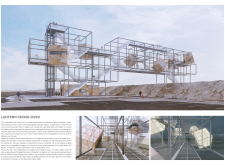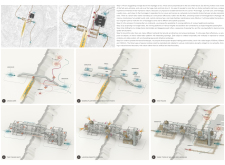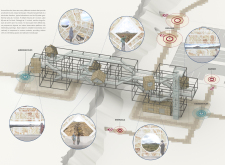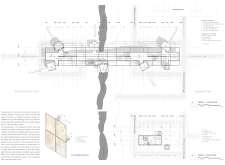5 key facts about this project
The project is located at the intersection of the Eurasian and North American tectonic plates in Iceland, where the landscape reveals an intriguing geological phenomenon. It serves as an observation structure that allows visitors to walk across a fissure marking the boundary of these two plates. By focusing on horizontal movement, the design promotes an experience that connects people to the unique geological characteristics of the area while harmonizing with the natural environment.
Bridge Concept
A shift is made from traditional vertical observation towers to a bridge-like structure. This design allows for a more direct interaction with the setting as visitors can traverse the fissure itself. The walking path complementing this bridge provides a means of exploration. It not only helps visitors move from one point to another but also encourages them to take in the surrounding views.
Viewing Platforms
Along the structure, several viewing platforms appear, each at different heights to enhance the experience. These platforms are designed to facilitate engagement with the landscape, focusing attention on significant features such as Hverfjall Volcano and Lake Mývatn. The staggered arrangement connects the platforms through bridge tracks. This staggered design invites a sense of discovery, leading visitors through the varied terrain.
Site Integration
In addition to the observation points, six distinct objects are integrated into the design, positioned to offer views of renowned attractions nearby. These objects serve as observation areas, enhancing how visitors experience the site. Walking path modules are proposed to protect the landscape. These path modules come in three sizes—300mm, 600mm, and 1200mm—allowing for thoughtful placement that respects the natural features of the area.
Façade Treatment
The façade employs a stone cladding system that uses thin onyx slabs placed between sheets of glass. This material choice allows light to interact with the building in interesting ways. During the day, the façade appears light and airy, blending with the environment. At night, the structure takes on a different character, lighting up like a lantern, guiding visitors as they explore the area.
The bridge-like structure offers a connection to its geological surroundings, presenting a practical space for observation and reflection.






















































